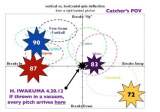 ............
............
Cool to see Felix' changeup starting to get some pub. Here's a fine USSM article that quotes a scout talking about a "beast mode" for Felix based on his changeup, a pitch we've called a "dry spitball."
As we've discussed any number of times :- ) over the past couple of years, the key to Felix' change is that it BOTH drops more than other changeups, and also comes in much harder.
It's like the L shape of an allen wrench. Because it is shaped so differently than other changeups, I would agree with folks who classify it as something other than a changeup. It's shaped like a splitfinger pitch, but better, and it's thrown harder. You could call it this: "Felix' Changeup." What other pitch is thrown 89 MPH and drops like a lead zeppelin? None, I don't think.
..........
Anyway, Felix' "changeup" is indeed a game-breaking weapon, so we Seattle Mariner fans might be interested to discover that Hasegawa's ... er, Iwakuma's shuuto is the same pitch as Felix' masterpiece weapon. The table below uses 2011 data for Felix, because F/X cannot distinguish this year between Felix' fastball and change.
It's true that Felix has thrown his changeup at around 89 MPH in the past, but his first two games of 2012, he threw it at 86 MPH, and it was just as deadly. He's inching back toward the 88, 89 mark as he builds strength.
Note also that he has thrown the changeup more every year, as he should. In fact, watching his game Thursday, I started to get a little worried. It seemed like, in a jam, Felix went to ONLY a fastball/changeup attack, all the way through 25-pitch innings. Ah, well. They used to say that Gaylord Perry would mix his pitches until he was in a game situation, and then you'd see 90% spitballs. Maybe there's nothing wrong with that.
Felix' changeup had a massive 1.80 runs value starting in 2007 -- meaning essentially that 100 changeups in a Strat-O game* would give him an ERA that is -1.80 better than league average -- and it's done nothing but climb since. In 2010-11 that baby was worth almost -3.00.
In 2012, so far, it's worth -5 runs per hundred changeups. Am not sure how that works, considering the league average ERA.
.
=== Said All That To Say This ===
 .........
.........
On the movement chart posted on Tango's site, Felix' changeup is at the outer rim of the "Changeup" circle -- and yet it is +6 MPH harder than other changeups. You expect changeups to sort of fall due to lack of velocity.
But! Iwakuma's shuuto is in a location not even catalogued by the MLB pitch type chart. His shuuto's movement is in the no-man's land that is wide left, and below, the changeup area.
Maybe this would be best.
.
| Velo | Drop vs avg MLB FB | Vert vs vacuum | Armside run | |
| AVG MLB Changeup | 83 | -4 inches | 4" rise | 6 inches |
| Felix' "changeup" | 88 | -7 inches | 1" rise | 6 inches |
| Iwakuma's "split" 4.20.12 | 87 | -9 inches | 1" drop ! | 10 inches |
Does that give you a feel for this situation?
...........
You might ask, "why don't other NPB pitchers with shuutos dominate." Who said they didn't? But:
1. Most shuuto's are 84-85 with nice armside run, and a little drop. Iwakuma's was 87 with massive drop. It's the difference between Felix' changeup and other mens' changeups.
2. NPB relievers have frequently been dominant in MLB.
3. Many NPB pitchers are thrashed when they get here.
4. I don't know whether Iwakuma can reliably throw this shuuto with that kind of drop.
But that pitch he threw on Friday, MLB hitters are not going to be able to hit that. Certainly RH hitters won't be able to.
BABVA,
Dr D
Add comment